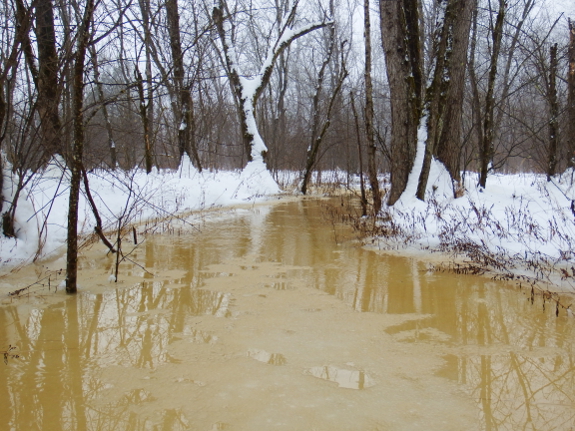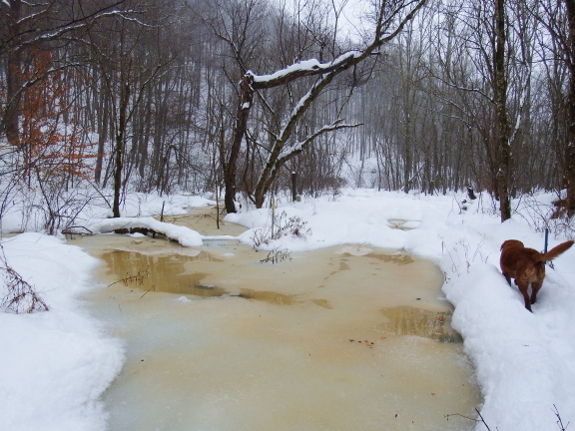
Two questions for our readers

After a warm weekend that
began to thaw our accumulated snow, another couple of inches of snow
fell Tuesday and set back my belief that spring will actually come. The
solution? Ignore the outdoors and write!
I'm working on two
different projects at the moment, and am hoping to pick our readers'
hive mind about both. The first project is the sequel to Farmstead Feast: Winter, imaginatively titled Farmstead Feast: Spring.
Even though this is supposed to be a cookbook, spring is also the time
to be planting to ensure that you have something to cook with, so I was
considering throwing in a quick section on how much area we devote to
each vegetable variety and when we plant in order to feed the two of us
all year. But, of course, that information will be only moderately
useful to people with different diets and who live in different climates
than us. Would you find that a handy appendix at the end of the spring
cookbook, or should I stick to recipes?

Second, I'm excited to announce that my fourth paperback,
The Ultimate Guide to Soil: A Gardener's Tips and Tricks for Organic, Nutrient-Rich, DIY Humus will be hitting bookstores in spring or summer 2016! I originally tried to sell Homegrown Humus
to my publisher, but they felt like cover crops were a little too much
of a niche subject. And when my editor came up with that alternative
title, I couldn't resist saying that I'd expand the book to include much
more than the topic I'd written about so far.
I'm planning on keeping The Ultimate Guide to Soil
much more hands-on than all of the soil books I've been perusing in
order to educate myself about the topic, so I'm devoting perhaps half of
the book to less mainstream methods home gardeners use to build the
soil. In addition to cover crops, I've planned sections on
remineralization, traditional compost, manure, bokashi, worm bins, black
soldier flies, compost tea, hugelkultur, biochar, humanure and urine,
leaf mould, and chop and drop. But I feel like there are more
soil-building techniques that I'm not thinking of at the moment. Maybe
you've got some ideas I should incorporate into the expanded book?
Please consider leaving me a comment and brightening this snowy day with
your ideas!
Want more in-depth information? Browse through our books.
Or explore more posts by date or by subject.
About us: Anna Hess and Mark Hamilton spent over a decade living self-sufficiently in the mountains of Virginia before moving north to start over from scratch in the foothills of Ohio. They've experimented with permaculture, no-till gardening, trailersteading, home-based microbusinesses and much more, writing about their adventures in both blogs and books.
Want to be notified when new comments are posted on this page? Click on the RSS button after you add a comment to subscribe to the comment feed, or simply check the box beside "email replies to me" while writing your comment.

Because you mention including some gardening tips in your cookbook, I'm wondering if you can focus more on your soil book and include types of soil in your woods, esp. the areas that had been extensively farmed (flood plain) or pastured; also the interplay with creeks, for ex problems with them, in gardening, for ex if good soil might be washed away, or if soil contaminates creeks.
About how to keep things simple with soil: the pH but also the good bugs, best temps for early Spring planting, also for Fall planting, and what happens in the soil at too cold or too hot (dry) times. How not to compact soil but also to rotate crops, in a small garden. (One thought I've had is to have planks down, to walk on, that can be lifted up, so the path area can then be used to grow in.And, how to have healthy soil in container gardens--that is, without being too technical, what good potting soil to use (for ex, is it nec. to sterilize home-made potting soil? Is it useful to put worms, etc into container pots? And how to actually improve soil around perennials and fruit trees... And, Using goose and duck droppings. thanks!
Hi Anna and Mark,
Both very good questions. I disagree with your idea that planting to feed will be much different for different people. Most people are about the same weight 100-200lbs.
I picked lots of apples from various abandoned trees. I still have plenty of apples. So a good mix for health as in how many pounds of which food groups is a very worthwhile subject to study.
All that said soils are MUCH different in their mineral profile. And for optimum health mineral balance says it ALL !!!!
The 'Ideal soil handbook' is a good beginning and your idea for a sequel book is IMHO also a VERY good idea and timely. A GOOD discussion of the origins of fertility would probably be MOST important to most of your readers. I have had amazing results with both seawater and granite dust. KNF also deserves some careful study and comment.
As would a discussion about the details (methods) used to measure what is in the soil, plant and animal tissues. Particularly regards 'nitrogen' which is mostly oversimplified and misunderstood.
Well, I don't mean to preach, but knowing how each element is measured seems to me to be a necessary beginning especially for real soil where results are VERY procedure dependent.
Maybe enough for now?
Nice ideas you have. Lots of fun.
John
p.s.- My real-time soil conductivity measurements show a continual rise in soil conductivity despite the VERY cold weather since the first week in January. It is fun to see what the soil is really doing under the snow :). nhfn.net/cond/cond.html
I'd love to read what and how much you plant for the two of you! I'm currently expanding into a much larger garden space and I'm a bit at a loss as to how much I need to plant, and this would be a really handy reference.
Sorry I don't have any input on your second question; it sounds to me like you've included a good variety of mulching and fertilizing options already.
Can't wait for your next book!
Anna,
I would use and appreciate an appendix.
I am meeting a friend tomorrow (if we don't get too much snow) to discuss planting flowers and herbs in and around my garden to attract pollinators. How about a section providing information for small flower species to help soil building, pollination and add variety to the garden? I am thinking about creating new smaller beds outside my fenced areas. The areas would be accessible to wildlife. Last year I planted basil, sage and dill inside my fenced area. Possible topics to write about: Which flowering species are easy to grow from seed and reasonably priced? Which are more difficult to grow? Do you recommend annuals or perennials? Should the soil be turned in the fall? Which species are best to add nitrogen and improve soil? I would like to plant Echinacea. Have you successfully planted it from seed?
I do not want a high maintenance flower garden. I want a functional pollination attracting area with herbs and flowers. Some will be used for canning, freezing and dehydrating. I live near Charlottesville, Va.
I enjoy reading your blog. Linda
If you're going to use German words, please use correct spelling: Hügelkultur (IPA: ˈhyːɡl̩ kʊlˈtuːɐ̯) for the general principle, and Hügelbeet (IPA: hyːɡl̩ beːt) for a bed. And don't forget to use capitals.
On the other hand you might consider just translating it to raised bed cultivation or raised bed gardening because the number of readers that can make sense of the original term would probably be relatively small.
Thanks to everyone for their handy thoughts --- keep them coming! From your comments, I've added a notation to add a section on soil in containers and one on wood chips.
Roland --- Good points! On the other hand, hugelkultur (lowercase with no accent) has been popularized into the American lexicon over the last decade or so (while hugelbeet would, presumably, leave most Americans scratching their heads). I think the Americanized version of the term is well enough known by now that translating it would confuse more people than it would help. (I wanted to use Google Ngram to see if my feeling on this topic is true, but they only seem to work through 2000, before the term hit the U.S.)
Well, just sayin I'm excited about both new books coming out. i vote "yes" on the gardening part of the recipe book. For the soil book, maybe some climate specific practices would be helpful. I just know tht trying to get anything to compost in the high altitude dry climate of the mountain southwest seemed next to impossible.
happy writing!
I'm exited about the new soil paperback, as Home Grown Humus is my favorite of your ebooks. It got my dad and me started with using buckwheat, and last year we began using it to rejuvenate his worn out garden soil-- the result of 5 seasons of conventional plow, rototill, 10-10-10 (cement would describe the texture well). We had considered starting with alfalfa, but your ebook helped us decide buckwheat was the way to go in beginning the process of putting organic matter back in the soil and filling the gaps where nothing was growing. Thanks!
In my own garden, the most important soil related thing I've learned from you (Weekend Homesteader) is the use of cardboard kill mulches. Two years ago I never would have imagined how much my gardening would change with this simple idea. I have discovered (from being lazy actually, and possibly having TOO MUCH cardboard laying around) that if I lay down a sheet of cardboard on a new garden area and leave it for a few weeks or a month, worms and other creatures do the work of tilling underneath, and generally nothing else is required to grow there. So naturally I'd like to see a section on the use of cardboard in the garden. Far too few people know about the benefits of this easy to find material.